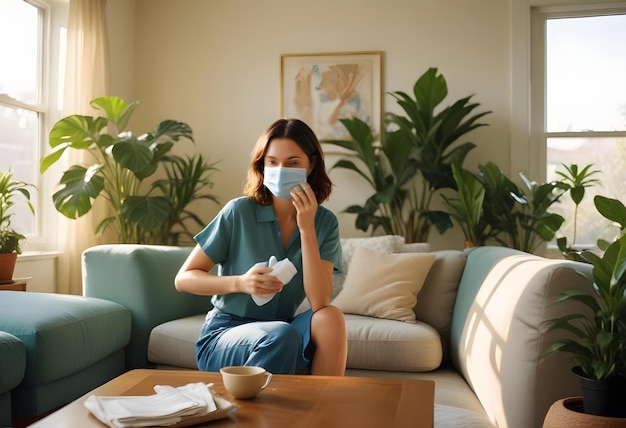Ensuring the air quality within our homes is crucial for maintaining good health and well-being. One common indoor pollutant that often goes unnoticed is formaldehyde, a volatile organic compound in many residential settings. This chemical can be emitted from various sources, such as building materials, furniture, and household products, posing a potential threat to human health.
This piece delves into the pervasive presence of formaldehyde in indoor air, exploring its health impacts, real-life cases in Singapore, and practical steps you can take to manage its levels effectively. Stay informed to protect yourself and your loved ones from this silent threat.
Health Impacts of Formaldehyde
Formaldehyde is a dangerous substance and should be avoided. It can pose significant health risks, particularly with prolonged exposure. However, not everyone exposed to formaldehyde will experience health issues. The likelihood of adverse health effects depends on several factors:
- Concentration of formaldehyde in the air – Higher concentrations increase the severe symptoms.
- Frequency and duration of exposure – Prolonged or repeated exposure heightens the risk of both immediate and chronic health effects.
- Time elapsed since exposure began – The duration between initial formaldehyde exposure and the first appearance of signs or symptoms can vary.
- Individual’s existing respiratory or breathing conditions – Individuals with pre-existing respiratory diseases are vulnerable to the effects of formaldehyde.
- Whether the person smokes – Smoking increases the risk of health issues from formaldehyde exposure. Smokers are more susceptible to respiratory problems because their lung function is already compromised.
Now, let’s take a closer look at the specific health effects it can cause. Understanding these is crucial for recognising the potential risks and taking appropriate steps to mitigate formaldehyde poisoning. – note/suggestion: we can link to the blog page of ‘formaldehyde poisoning’ here once it is published
Eyes
Exposure to formaldehyde can cause eye irritation, leading to redness, tearing, and burning sensations. In extreme cases, particularly at high concentrations, formaldehyde can cause chemical burns and damage to the cornea, potentially resulting in long-term visual impairment if not treated promptly.
Skin
Direct contact with formaldehyde can result in skin irritation, including redness, rashes, and burns. Prolonged exposure can lead to dermatitis, a condition characterised by inflamed, itchy, and cracked skin. If you have sensitive skin or existing conditions, formaldehyde exposure can worsen symptoms, potentially leading to scarring or infections.
Inhalation
Inhaling formaldehyde poses significant risks to the respiratory system. The chemical can irritate the nose, mouth, throat, and lungs, leading to symptoms such as coughing, wheezing, and a burning sensation in the airways. At higher concentrations, formaldehyde can cause pulmonary oedema, where fluid sits in the lungs, leading to severe shortness of breath and potentially life-threatening complications.
Chronic Health Effects
One of the most serious long-term risks of formaldehyde exposure is its carcinogenic potential. Formaldehyde has been classified as a known human carcinogen linked to cancers of the nasopharynx (upper part of your throat) and certain types of leukaemia. Studies have shown that workers in industries with prolonged exposure to high levels of formaldehyde face an increased risk of developing these cancers. While the exact mechanisms are still under investigation, the consistent link between formaldehyde and cancer highlights the importance of minimising exposure whenever possible.
Cases in Singapore
In Singapore, formaldehyde exposure has become a big public health concern, particularly linked to indoor air pollutants from furniture and building materials. This case study examines three notable incidents highlighting the health risks of formaldehyde and the actions taken by affected individuals and authorities.
Case 1: Formaldehyde Emissions from Wooden Furniture
In a case reported by Channel News Asia, a family moving into a new flat in Hougang experienced persistent health issues, including frequent illnesses among their children. After several months of discomfort, they discovered that formaldehyde emitted from wooden furniture was the culprit. The family sought help by purchasing removal gels and activated charcoal but ultimately engaged an air quality specialist who confirmed elevated formaldehyde levels using a meter. The specialist treated their home, reducing the concentration to safe levels after extensive remediation.
Case 2: Family Falls Sick Due to Formaldehyde in New Home
Another alarming incident involved a family that moved into a newly renovated condominium at Normanton Park. Shortly after their move, they began experiencing symptoms such as dry eyes and sore throats. Medical evaluations revealed high levels of formaldehyde in their furniture, with one drawer containing concentrations 60 times above the acceptable limit. The family took steps to counter exposure by improving ventilation and using air purifiers, while also advocating for stricter regulations on formaldehyde emissions in household products.
Case 3: Formaldehyde in Wood Products and Adhesives – A National Concern
A Channel News Asia report highlighted broader concerns about formaldehyde emissions from wood products and adhesives used in construction and furnishings. The National Environment Agency (NEA) conducted investigations and found that some homes had formaldehyde levels exceeding safe limits. These findings raised concerns about public health, prompting discussions on stricter regulations regarding the use of formaldehyde in household products and building materials.
Additionally, NEA announced new regulations prohibiting the sale of interior paints containing formaldehyde starting January 1, 2026. This decision reflects growing concerns about the chemical’s health risks, including respiratory issues and potential carcinogenic effects.
How Can Indoor Air Quality Be Managed Effectively?
Managing indoor air quality effectively requires a multifaceted approach, with a strong emphasis on adhering to legal policies and regulations, regular air quality testing, and engaging professional services for formaldehyde removal. In many countries, including Singapore, national environmental agencies have established guidelines and permissible exposure limits (PELs) for indoor air pollutants, including formaldehyde. Compliance with these standards is crucial for safeguarding health, especially in indoor spaces where formaldehyde can accumulate over time.
There are two main types of testing:
- DIY Testing Kits: Homeowners can purchase air quality testing kits that measure formaldehyde levels in indoor environments. These kits are a cost-effective way to monitor air quality, but their accuracy may vary.
- Professional Testing Services: For more accurate and comprehensive results, it is advisable to hire professional air quality specialists. These experts use advanced equipment to detect formaldehyde and other indoor pollutants, providing a detailed analysis of air quality and recommendations for improvement.
What Can You Do to Minimise Formaldehyde Exposure in Your Home?
- Regularly open windows to allow fresh air to circulate, which helps dilute indoor pollutants, including formaldehyde. Aim to ventilate your home for a few minutes every few days, especially after introducing new products.
- Install and utilise exhaust fans in kitchens and bathrooms to improve air circulation and expel contaminants.
- Maintain indoor humidity levels between 30% and 50%. High humidity can increase formaldehyde emissions from materials. Use dehumidifiers to manage moisture levels.
- Keep your home at a comfortable yet lower temperature, as higher temperatures can elevate formaldehyde release from products.
- Establish smoke-free policies in your home to eliminate exposure to cigarette smoke, which contains formaldehyde and other harmful compounds.
- When purchasing furniture or construction materials, look for items labelled as low or no formaldehyde emissions.
- Opt for solid wood furniture instead of pressed wood pro, as it does not contain formaldehyde-based adhesives.
- Use low-VOC or zero-VOC paints and finishes during renovation projects to reduce formaldehyde emissions.
- Allow new furniture and products to off-gas outdoors before bringing them inside. This can be done by unboxing items in a garage or patio until the chemical odour dissipates.
- Wash permanent-press clothing, curtains, and other textiles before use to reduce formaldehyde exposure from these items.
- Consider using air purifiers equipped with activated carbon filters specifically designed to capture formaldehyde and other VOCs from the air.
- Maintain cleanliness in your home by regularly dusting and vacuuming with a HEPA filter vacuum cleaner to minimise dust accumulation that may harbour pollutants.
- If you have concerns about formaldehyde exposure, consider hiring a professional to conduct air quality tests.
- Pay attention to symptoms that may indicate high levels of formaldehyde. Seek medical advice if symptoms persist.
- If you have identified high formaldehyde levels in your home, consider hiring a professional service to address the issue effectively.
Total Cleanz specialises in Formaldehyde Removal Services, utilising advanced techniques to ensure your indoor environment is safe and healthy. Our professionals not only excel in removing formaldehyde but also offer comprehensive air quality testing to identify the full spectrum of indoor contaminants. By choosing Total Cleanz, you can benefit from our extensive experience and commitment to creating safer living spaces, giving you peace of mind and improving the health conditions within your home.
By following these tips, you can significantly reduce your exposure to formaldehyde and create a healthier indoor environment for you and your family.
Conclusion
Formaldehyde exposure in indoor spaces leads to health issues, particularly for vulnerable populations like children, the elderly, and those with respiratory conditions. By understanding the sources and impact of formaldehyde and taking proactive steps—you can minimise the risk.
Stay informed and vigilant about the quality of your indoor air, and protect your loved ones from the potential dangers of formaldehyde.
Prioritise health by partnering with professionals who can guide in creating an environment free from hazardous air pollutants.











